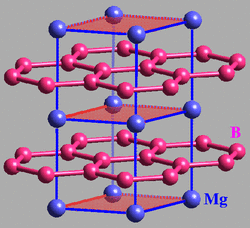
Structure of MgB2.
Nearly all of today's clinical superconducting MR magnets employ superconducting coils made of
niobium-titanium (NbTi), an alloy with transition temperature (Tc) of 9.4°K. An upcoming "high temperature" superconductor to watch is magnesium diboride (MgB2), with Tc = 39°K. MgB2 is already used in a number of laboratory NMR instruments and other industrial applications. At present a single company (Paramed Medical Systems, Genova, Italy) manufactures a whole body cryogen-free 0.5T superconducting scanner made of this material.
A second current clinical application of high-temperature superconductors is in their use for RF-receiver coils. A Chinese company (Time Medical Systems) now offers a commercial MR system using superconducting receiver coils constructed of YiBaCuO and BiSrTiCaO. These materials have superconducting transition temperatures in the range of 90°K and are cooled by liquid nitrogen.
On the distant horizon are a class of atypical superconductors that operate at much higher temperatures. As of September 2013, there are 7 reported materials superconductive in the room-temperature range. The most recent of these (with the impressive chemical formula Tl5Sn2Ba2SiCu8O16+) has a transition temperature near 42°C (107ºF, 315°K).
niobium-titanium (NbTi), an alloy with transition temperature (Tc) of 9.4°K. An upcoming "high temperature" superconductor to watch is magnesium diboride (MgB2), with Tc = 39°K. MgB2 is already used in a number of laboratory NMR instruments and other industrial applications. At present a single company (Paramed Medical Systems, Genova, Italy) manufactures a whole body cryogen-free 0.5T superconducting scanner made of this material.
A second current clinical application of high-temperature superconductors is in their use for RF-receiver coils. A Chinese company (Time Medical Systems) now offers a commercial MR system using superconducting receiver coils constructed of YiBaCuO and BiSrTiCaO. These materials have superconducting transition temperatures in the range of 90°K and are cooled by liquid nitrogen.
On the distant horizon are a class of atypical superconductors that operate at much higher temperatures. As of September 2013, there are 7 reported materials superconductive in the room-temperature range. The most recent of these (with the impressive chemical formula Tl5Sn2Ba2SiCu8O16+) has a transition temperature near 42°C (107ºF, 315°K).
Advanced Discussion (show/hide)»
No supplementary material yet. Check back soon!
References
HTS White Paper (pdf). Time Medical Systems, 2010. (Sales brochure of a company that manufactures RF coils using high temperature superconductive technology).
Ma QY, Chan KC, Kacher DF et al. Q. Y. Ma, K. C. Chan, Daniel F. Kacher. Superconducting RF coils for clinical MR imaging at low field. Acad Radiol 2003; 10:978-987.
Paramed Medical Systems (website link), Genova, Italy. (Produces the only current commercially available MR scanner using MgB2 superconducting coils).
Shcherbakov AV. Magnesium diboride superconductor: thermal stabilization and doping. Doctor of Philosophy thesis, Institute for Superconducting and Electronic Materials, University of Wollongong, 2011.
Superconduction.org website. (Good explanations of superconductivity and the latest news about room temperature superconductors and other advances in the field).
HTS White Paper (pdf). Time Medical Systems, 2010. (Sales brochure of a company that manufactures RF coils using high temperature superconductive technology).
Ma QY, Chan KC, Kacher DF et al. Q. Y. Ma, K. C. Chan, Daniel F. Kacher. Superconducting RF coils for clinical MR imaging at low field. Acad Radiol 2003; 10:978-987.
Paramed Medical Systems (website link), Genova, Italy. (Produces the only current commercially available MR scanner using MgB2 superconducting coils).
Shcherbakov AV. Magnesium diboride superconductor: thermal stabilization and doping. Doctor of Philosophy thesis, Institute for Superconducting and Electronic Materials, University of Wollongong, 2011.
Superconduction.org website. (Good explanations of superconductivity and the latest news about room temperature superconductors and other advances in the field).
Related Questions
How are superconducting magnets constructed?
Isn't superconduction like perpetual motion? Doesn't the current in the superconducting coils ever slow down?
Don't superconducting scanners consume liquid helium? How often does it need to be replenished?
How are superconducting magnets constructed?
Isn't superconduction like perpetual motion? Doesn't the current in the superconducting coils ever slow down?
Don't superconducting scanners consume liquid helium? How often does it need to be replenished?
